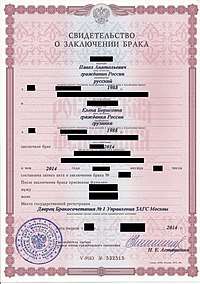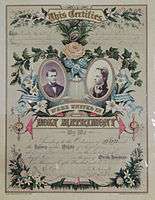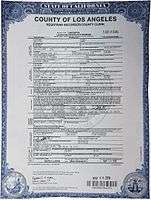Marriage certificate
A marriage certificate (sometimes: marriage lines) is an official statement that two people are married. In most jurisdictions, a marriage certificate is issued by a government official only after the civil registration of the marriage.
| Family law |
|---|
| Family |
|
Marriage and other equivalent or similar unions and status |
|
Other issues
|
|
Family and criminal code (or criminal law) |
In some jurisdictions, especially in the United States, a marriage certificate is the official record that two people have undertaken a marriage ceremony. This includes jurisdictions where marriage licenses do not exist. In other jurisdictions, a marriage license serves a dual purpose of granting permission for a marriage to take place and then endorsing the same document to record the fact that the marriage has been performed.
A marriage certificate may be required for a number of reasons. It may be required as evidence of change of a party's name, on issues of legitimacy of a child, during divorce proceedings, or as part of a genealogical history, besides other purposes.
Australia
Though marriage in Australia is regulated under federal law, the registration of marriages takes place under the respective state or territory laws, generally through an agency named "Registry of Births, Deaths and Marriages"[1] or similar, and marriage certificates are issued by these agencies. Under Federal law, a certificate is issued at the time of marriage by a celebrant, for forwarding to the state or territory registry. A similar (sometimes cut-down) document is often given to the couple on the day of the marriage, it is generally handwritten. While legally valid as proof of marriage, is not generally acceptable as an official document. However, the state or territory marriage certificate is considered to be an acceptable and secure secondary identity document especially for the purposes of change of name, and needs to be obtained separately for a fee generally some time after the marriage. This document can be verified electronically by the Attorney-general of Australia's Document Verification Service.[2] States and territories sometimes market commemorative marriage certificates, which generally have no official document status.[3]
State and territory issued certificates are on A4 paper and provide: Date and place of marriage, full names, occupations, addresses, marital status (never validly married, divorced, widow/er), birth date & place, age, father's name, mother's maiden name of each the couple, the celebrant, witness names (generally two), the registrar official of the state or territory authority, and the date of registration. The registrar's signature and seal is printed/embossed on the certificate along with a number, and date of issue of certificate.
Marriage certificates are not generally used in Australia, other than to prove change-of-name, and proof of marital status in a divorce hearing. Some visa categories require a certificate (where a partner is to be associated with a primary applicant),[4] however there are similar categories of partner visas that do not.[5]
Since 2018, Australian federal law has recognised same-sex marriages.[6] These marriages are registrable and documented in the conventional way.
United Kingdom

England and Wales
A marriage certificate is given to a couple who have married. Copies are made in two registers: one is retained by the church or register office; the other, when the entire register is full, is sent to the superintendent registrar of the registration district. Every quarter, the minister or civil registrar prepares a further copy of all the marriage entries and sends them to the Registrar General.[7]
The certificate lists the date of the marriage, and the full names of both spouses. Their ages are included (it is also permissible to write "full", meaning of age, and until 1850 some 75% of certificates said that; if the certificate reads "minor" or "under age", it means that, until 1929 when the law changed to 16, the bride was between 12 and 20 and the groom 14 and 20 years of age).
The certificate does not contain a specific record of the intended new surname(s), if one or both spouses wish to change their name. However, if a wife wishes to take her husband's surname, a marriage certificate obtained in England or Wales recording both her maiden name and her husband's name is supposed to be sufficient evidence for getting her name changed on, for example, her bank account[8] and any UK bank that rejects such a marriage certificate as evidence is in error.
The certificate also records the previous marital status of both spouses. Those not previously married were "bachelor" or "spinster." From 1858 to 1952 a previously divorced groom was listed as "the divorced husband of…" with his ex-wife's maiden name listed, and vice versa for a divorced bride. The currently used wording is "previous marriage dissolved" with no further details given. On the 5th September 2005, the Registrar General in England and Wales officially abolished the traditional terms of "bachelor" and "spinster" and substituted "single" to coincide with the reform that introduced civil partnerships, explaining, "The word single will be used to mean a couple who has never been through a marriage or civil partnership."[9]
Origins of the system
On the 1st July 1837, civil registration was introduced in England and Wales, providing a central record of all births, deaths and marriages. A Registrar General was appointed with overall responsibility and the country was divided into registration districts, each controlled by a superintendent registrar. Under this system, all marriage ceremonies have been certified by the issuing of a marriage certificate whose details are also stored centrally. From that date onward, marriage ceremonies could be performed, and certificates issued either by a clergyman of the Church of England, in a parish church, or by a civil registrar in a civil register office. Marriages performed according to the ceremonies of Quakers and Jews also continued to be recognised as legal marriages, and certificates were issued.
Russia

A certificate of marriage is the only legally valid document on the registration of marriage in Russia. Issued in the certification of the fact of state registration of the civil status act, signed by the head of the registry office and is sealed with its seal.[10]
A state registration fee of 350 rubles is charged for state registration of acts of civil status.
For the marriage, the couple must file a joint statement confirming mutual voluntary consent for the conclusion of the marriage union, as well as the absence of circumstances preventing marriage. Future spouses sign a joint statement and indicate the date of its compilation. Simultaneously with the application it is necessary to provide documents proving the identity of future spouses; documents confirming the termination of the previous marriage, if any; permission to enter into marriage before reaching the marriageable age, if the person (person) entering into marriage is a minor.[10]
The certificate of marriage contains the following information:[10]
- Surname (before and after the marriage), name, patronymic, date and place of birth, citizenship and nationality (if indicated in the record of the act of marriage) of each of the persons married
- Date of marriage
- Date of compilation and the number of the record of the marriage certificate
- Place of state registration of marriage, namely the name of the registry office chosen by future spouses at will in the territory of the Russian Federation
- Date of issue of the marriage certificate
United States
In parts of the United States, the certificate of marriage is recorded on the same document as the marriage license or application for marriage. While each state creates their own form for use with the recording of marriages, most states have a specific portion of the record to be completed by the official performing the ceremony.
In some states, such as Nevada, this portion also includes places for the parties to indicate a change in name, if any. If it does not, the marriage certificate can be used as documentation to justify a legal name change but not as proof that a name change has occurred. If there is no place for a change of name to be recorded, the name is changed as requested on government documents with proof of marriage.
Confidential marriages
In California, under Section 501 of the state's Family Code, a county clerk is authorised to issue a confidential marriage licence and subsequently grant a confidential marriage certificate; Section 511 of the same Code states that the records of marriages registered under this provision are not open to public inspection, except by an order of the court. This practice originated in 1878, and was originally intended for those persons in a common-law relationship who presented themselves as married and wanted to make such marriage official. The practice of confidential marriages is unique to California, and is only approximated by Michigan, which offers court-ordered secret marriages.[11]
Consular marriages
Prior to 1989, the U.S. Department of State offered a Certificate of Witness to Marriage (form FS-97)[12] for those couples whose marriages were solemnised in the presence of a consular official overseas. This was authorised by 22 U.S.C. 4192 on the condition that the parties had to be free to contract marriage under the laws of the District of Columbia.[13] On November 9th, 1989, this provision of the United States Code was repealed, and the Department accordingly ceased issuing such certificates.[14]
 A Michigan marriage certificate, issued 1883.
A Michigan marriage certificate, issued 1883. A California confidential marriage certificate, issued 2015.
A California confidential marriage certificate, issued 2015. A State Department certificate of witness to marriage, issued 1948.
A State Department certificate of witness to marriage, issued 1948.
References
- Agency, Digital Transformation. "Births, deaths and marriages registries – australia.gov.au". Australia.gov.au. Retrieved 21 May 2018.
- "Archived copy". Archived from the original on 21 March 2017. Retrieved 7 April 2017.CS1 maint: archived copy as title (link)
- "Marriage certificate". Bdm.nsw.gov.au. Retrieved 21 May 2018.
- "Archived copy". Archived from the original on 7 April 2017. Retrieved 7 April 2017.CS1 maint: archived copy as title (link)
- "Partner visa (subclasses 820 and 801)". Border.gov.au. Retrieved 21 May 2018.
- "Marriage Act". Federal Register of Legislation. 9 December 2017.
Refer to Part 1 (Subsection 8) of the Act
- "Marriage Act 1949". Legislation.gov.uk. Retrieved 21 May 2018.
- "Advice for a woman getting married". Deed Poll Office. Retrieved 18 August 2019.
- "R.I.P Bachelors and Spinsters". News.bbc.co.uk. 14 September 2005. Retrieved 21 May 2018.
- "Федеральный закон от 15.11.1997 N 143-ФЗ (ред. от 31.12.2014) "Об актах гражданского состояния"". Российская газета, №224. 20 November 1997. Retrieved 17 February 2018.
- "What Is a Confidential Marriage License and Why Does California Offer Them?". www.mentalfloss.com. 11 November 2015. Retrieved 18 April 2020.
- "7 FAM 1450 MARRIAGE OF U.S. CITIZENS ABROAD". fam.state.gov. Retrieved 25 May 2020.
- States, United (1976). United States Code: Supplement. Office of the Law Revision Counsel of the House of Representatives.
- "Certificate of Witness to Marriage Law and Legal Definition". USLegal.
External links
| Wikimedia Commons has media related to Marriage certificates. |